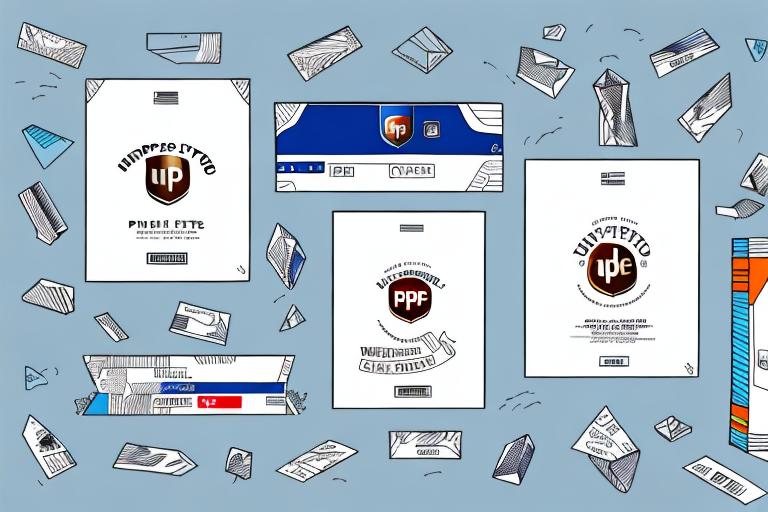Comparing 25-lb Parcel Shipping Rates for UPS, USPS, and FedEx
In today's e-commerce-driven market, efficient shipping and handling are pivotal for business success. Selecting the right carrier—such as UPS, FedEx, or USPS)—can significantly impact your operational costs and customer satisfaction. This article delves into the factors to consider when choosing a shipping carrier for 25-lb parcels, methods to calculate shipping costs, and strategies to optimize cost savings, enabling you to make informed decisions tailored to your business needs.
Introduction: The Need for Comparing Shipping Rates for 25-lb Parcels
Shipping rates are a critical consideration for businesses, influenced by factors such as carrier choice, destination, parcel size and weight, and delivery speed. For medium-sized packages like 25-lb parcels, shipping costs can represent a substantial portion of operational expenses. According to the 2023 E-commerce Report, shipping costs account for approximately 30% of total fulfillment expenses for online retailers.
Comparing shipping rates across major carriers ensures you secure the most competitive pricing while meeting delivery expectations. This comparison should extend beyond rates to include considerations like delivery speed, reliability, and ancillary services such as tracking and insurance. By evaluating these aspects, businesses can optimize their shipping strategies to enhance profitability and customer satisfaction.
The Importance of Choosing the Right Shipping Carrier
Selecting the appropriate shipping carrier is essential for maintaining cost efficiency and ensuring reliable delivery. Shipping costs can significantly impact your profit margins, with even minor rate differences accumulating over large shipment volumes. Moreover, carrier reliability affects customer satisfaction and brand reputation. A study by Harvard Business Review highlights that 80% of customers consider timely delivery a key factor in their overall satisfaction with e-commerce purchases.
Key factors in selecting a carrier include:
- Delivery Options: Availability of various delivery speeds, from same-day to standard ground shipping, allowing flexibility based on business needs and customer expectations.
- Customer Service: Accessible and responsive customer support to handle issues such as delays, damages, or lost packages efficiently.
- Additional Services: Offerings like package tracking, insurance, and signature confirmation that add value to your shipping process.
Evaluating these factors ensures that you choose a carrier that not only provides competitive rates but also aligns with your service quality standards.
Factors to Consider When Choosing a Shipping Carrier
When selecting a shipping carrier for 25-lb parcels, consider the following key factors:
- Delivery Speed: Assess whether the carrier offers expedited options if your business requires fast delivery times.
- Reliability: Examine the carrier's track record for on-time deliveries and minimal loss or damage rates. According to the Consumer Reports Shipping Accuracy Study 2023, UPS and FedEx consistently rank higher in delivery reliability compared to USPS.
- Customer Service: Evaluate the accessibility and effectiveness of the carrier’s customer support in resolving shipping issues.
- Shipping Rates: Compare the cost per shipment, taking into account any volume discounts or special rates available for businesses.
- Coverage Area: Ensure the carrier can deliver to all regions relevant to your business operations, including international destinations if applicable.
By thoroughly assessing these factors, you can select a carrier that aligns with both your budgetary constraints and service quality expectations.
Understanding the Different Shipping Services Offered by UPS, USPS, and FedEx
Each major carrier—UPS, USPS, and FedEx—provides a range of shipping services tailored to different needs:
- USPS:
- Priority Mail: Offers delivery within 1-3 business days with tracking.
- Priority Mail Express: Provides overnight delivery to most U.S. locations.
- First-Class Mail: Ideal for smaller, lightweight packages.
- FedEx:
- FedEx Ground: Ground shipping with delivery typically in 1-5 business days.
- FedEx Home Delivery: Residential delivery service with similar timelines to FedEx Ground.
- FedEx Express: Priority shipping options for faster delivery needs.
- UPS:
- UPS Ground: Reliable ground shipping with delivery in 1-5 business days.
- UPS Next Day Air: Guaranteed next-business-day delivery.
- UPS 2nd Day Air: Delivery within two business days.
Understanding these service options is crucial for selecting the most appropriate and cost-effective solution for your shipping requirements. For instance, USPS Priority Mail may be more economical for domestic shipments of moderate size, while FedEx Express is suitable for urgent, time-sensitive deliveries.
Additionally, each carrier has distinct pricing structures. USPS typically offers competitive rates for smaller packages and domestic shipments, whereas FedEx and UPS may provide better rates for larger packages and international deliveries. It's essential to analyze your shipping patterns and requirements to choose the carrier that offers the best value.
How to Calculate Shipping Costs for 25-lb Parcels
Calculating shipping costs accurately is vital for budgeting and pricing your products. Here's a step-by-step guide to determining the shipping cost for a 25-lb parcel:
- Gather Package Details: Note the weight (25 lbs) and dimensions of the parcel. Some carriers, like UPS, require exact dimensions, while others may base rates primarily on weight.
- Select Shipping Service: Choose the desired shipping service level (e.g., ground, express) based on your delivery timeline.
- Enter Destination Information: Input the origin and destination ZIP codes to determine the shipping zone.
- Use Carrier Rate Calculators: Utilize the shipping calculators available on each carrier’s website:
- Compare Rates: Analyze the rates provided by each carrier for the selected service and destination.
- Consider Additional Costs: Factor in any additional fees for fuel surcharges, residential delivery, or insurance.
For example, shipping a 25-lb parcel from New York to California via UPS Ground might cost approximately $40, whereas USPS Priority Mail could be around $35, and FedEx Ground approximately $38. These prices can vary based on current rates and specific service options.
Furthermore, businesses regularly shipping parcels may qualify for discounted rates through carrier contracts or third-party shipping software. Exploring these options can lead to significant savings over time.
Comparison of Shipping Rates for 25-lb Parcels across Different Zones
Shipping rates fluctuate based on the origin and destination zones. Carriers divide the country into zones, with higher rates typically required for shipments traveling longer distances or to more remote areas. For instance, sending a 25-lb parcel from New York to California (Zone 8) will incur higher shipping costs compared to shipping within the same state (Zone 2).
Here is a general comparison of estimated costs for a 25-lb parcel across different zones:
| Carrier | Zone 2 (Same State) | Zone 5 (Moderate Distance) | Zone 8 (Long Distance) |
|---|---|---|---|
| UPS Ground | $30 | $40 | $50 |
| USPS Priority Mail | $28 | $38 | $48 |
| FedEx Ground | $32 | $42 | $52 |
These estimates are illustrative and actual rates may vary based on current pricing, fuel surcharges, and specific carrier promotions. Businesses should use the carriers' rate calculators for precise pricing.
Additionally, bulk shipping or business accounts may offer discounted rates that further reduce costs across all zones. It's advisable to negotiate with carriers based on shipping volume to maximize savings.
Analysis of Cost Savings on Shipping Rates for 25-lb Parcels
Optimizing shipping carrier selection can lead to significant cost savings. Even marginal rate differences can accumulate substantially with high shipping volumes. For example, saving $5 per parcel on 1,000 shipments results in a $5,000 annual savings.
Frequency of Shipments: Businesses with frequent shipments can leverage higher volume discounts. UPS and FedEx offer tiered pricing structures where shipping rates decrease as shipment volume increases.
Negotiating Rates: Direct negotiations with carriers can yield better rates, especially for businesses with substantial shipping needs. Engaging in contract negotiations or joining carrier loyalty programs can unlock additional discounts.
Reliability and Speed Trade-offs: While selecting the cheapest option saves money upfront, it's crucial to balance cost with reliability. Delays or lost shipments can incur indirect costs, such as lost sales and diminished customer trust. Therefore, choosing a carrier that offers both competitive rates and high reliability ensures long-term savings and customer satisfaction.
According to the Forbes Shipping Strategies Report 2023, businesses that regularly review and adjust their shipping strategies based on current market conditions achieve an average of 15% reduction in shipping-related expenses.
Pros and Cons of Using UPS, USPS, and FedEx for 25-lb Parcel Shipments
Each carrier has its unique strengths and potential drawbacks. Understanding these can help you align carrier capabilities with your business priorities.
- UPS:
- Pros: High reliability with consistent on-time delivery, extensive tracking capabilities, and a wide range of service options.
- Cons: Generally higher shipping costs compared to USPS for similar services, especially for lighter parcels.
- USPS:
- Pros: Most affordable for domestic shipments and smaller packages, includes free package tracking and insurance up to a certain amount.
- Cons: Longer delivery times for certain services, variable reliability in remote areas.
- FedEx:
- Pros: Fast delivery options with excellent customer service, reliable for both domestic and international shipments.
- Cons: More expensive, particularly for international shipping and expedited services.
Choosing the right carrier involves weighing these pros and cons against your business's specific needs, such as budget constraints, delivery timelines, and service quality expectations.
Best Practices for Reducing Shipping Costs for 25-lb Parcels
Implementing strategic practices can help minimize shipping expenses while maintaining service quality:
- Negotiate with Carriers: Engage in discussions with carriers to obtain better rates based on your shipping volume and frequency.
- Optimize Package Size and Weight: Ensure parcels are as compact and lightweight as possible to qualify for lower shipping tiers.
- Compare Rates Regularly: Shipping rates can fluctuate; regularly compare rates from different carriers to capitalize on the best deals.
- Utilize Shipping Aggregators: Services like ShipStation or Shippo consolidate shipping options, potentially offering discounted rates through negotiated partnerships.
- Implement Efficient Packaging Practices: Reduce the use of excessive packaging materials to lower both weight and dimensional weight charges.
Adopting these best practices can lead to substantial cost savings and more efficient shipping operations. For instance, companies that switch to streamlined packaging have reported up to a 10% reduction in shipping costs.
Additionally, leveraging technology through shipping software can automate rate comparisons and label printing, thereby saving time and reducing human error.
Conclusion: Making an Informed Decision on Shipping Carriers
Shipping is a critical element of business operations, directly affecting both costs and customer satisfaction. Selecting the right carrier for 25-lb parcels involves a comprehensive evaluation of delivery speed, reliability, customer service, and shipping rates. By carefully assessing each carrier's offerings and implementing cost-reduction strategies, businesses can optimize their shipping processes to enhance profitability and maintain high service standards.
Regularly reviewing shipping performance and staying informed about industry trends ensures that your shipping strategy remains effective and cost-efficient. We hope this analysis provides the insights necessary to make informed decisions that align with your business's shipping needs and financial goals.




















